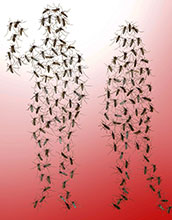Multimedia Gallery
Aedes aegypti mosquitoes drawn to humans
These hungry Aedes aegypti mosquitoes are drawn to human odor, evoking the iconic image of a man and women that were sent into space on the Pioneer plaque.
More about this image
It's known that female mosquitoes can track a human down by the smell of the carbon dioxide (CO2) we exhale, but once they get close, they tend to gravitate toward exposed areas of skin such as ankles and feet, being drawn there by skin odors.
Scientists at the University of California, Riverside, found that the very receptors in a mosquito's maxillary palp that detect CO2 are the ones that detect skin odors as well, thus explaining why mosquitoes are attracted to skin odor--smelly socks, worn clothes, bedding--even in the absence of CO2.
The new finding--that the CO2-sensitive olfactory neuron is also a sensitive detector of human skin--is critical not only for understanding the basis of the mosquito's host attraction and host preference, but also because it identifies this dual receptor of CO2 and skin-odorants as a key target that could be useful to disrupt host-seeking behavior and thus aid in the control of disease transmission.
This research was supported in part by a grant from the National Science Foundation. To learn more, see the UC-Riverside news story How mosquitoes are drawn to human skin and breath. (Date of Image: October 2013)
Credit: Genevieve Tauxe, University of California, Riverside
Images and other media in the National Science Foundation Multimedia Gallery are available for use in print and electronic material by NSF employees, members of the media, university staff, teachers and the general public. All media in the gallery are intended for personal, educational and nonprofit/non-commercial use only.
Images credited to the National Science Foundation, a federal agency, are in the public domain. The images were created by employees of the United States Government as part of their official duties or prepared by contractors as "works for hire" for NSF. You may freely use NSF-credited images and, at your discretion, credit NSF with a "Courtesy: National Science Foundation" notation.
Additional information about general usage can be found in Conditions.
Also Available:
Download the high-resolution JPG version of the image. (1.4 MB)
Use your mouse to right-click (Mac users may need to Ctrl-click) the link above and choose the option that will save the file or target to your computer.

